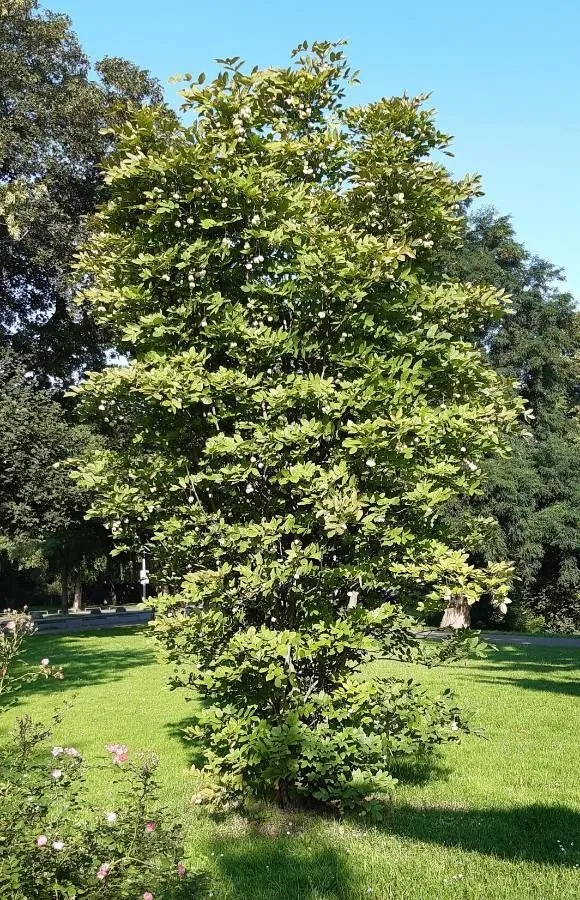
Author: L.
Bibliography: Sp. pl. 1:270. 1753
Year: 1753
Status: accepted
Rank: species
Genus: Staphylea
Vegetable: False
Observations: EC. & SE. Europe to Caucasus
The Bladdernut, known scientifically as Staphylea pinnata, is a distinctive and intriguing plant that belongs to the Staphyleaceae family. This perennial shrub, first described in 1753 by the eminent botanist Carl Linnaeus, finds its origins and optimum growing conditions in the varied landscapes of Eastern and Southeastern Europe extending to the vibrant regions of the Caucasus.
Characterized by its unique bladder-like seed pods, the Bladdernut is easily identifiable and often sought after for ornamental purposes. These pods, which give the plant its common name, develop from inconspicuous yet attractive creamy-white flowers that bloom in the spring. Once pollinated, these flowers transform into the air-filled fruits that dangle elegantly, adding visual interest throughout the summer and into the fall.
The foliage of the Bladdernut complements its distinctive fruits. Exhibiting a pinnate leaf structure, the leaves are lush and green during the growing season, turning to various shades of yellow in the autumn, thus contributing to the seasonal tapestry of the landscape. These features make the Bladdernut a valuable addition to gardens and naturalized areas, providing year-round interest.
Adapted to the temperate climates of its native range, the Bladdernut thrives in regions with moderate to cool temperatures. It is versatile in terms of soil preferences, tolerating a range of conditions from well-drained fertile soils to more challenging environments, as long as there is adequate moisture.
Ecologically, Staphylea pinnata plays a role in supporting wildlife. The flowers attract various pollinators, including bees and butterflies, while the seeds are a food source for certain bird species. This interaction underscores the plant’s importance beyond its aesthetic qualities, contributing to the biodiversity and health of its native ecosystems.
In summary, Staphylea pinnata, or the Bladdernut, is a plant of significant botanical interest with its intriguing seed pods, beautiful foliage, and ecological benefits. From gardens to wild landscapes, it stands out as a plant that offers both beauty and function, worthy of recognition and appreciation.
Eng: bladdernut, european bladdernut, anthony nut
Dan: blærenød
Deu: gefiederte pimpernuss, pimpernuss, pimpernuß
Swe: pimpernöt, vanlig pimpernöt
Nld: pimpernoot, europese pimpernoot
Cym: cnau aur onnenddail, cnau codog, cneuen godog, dagrau addaf
En: Bladdernut, European Bladdernut, Anthony Nut, Bladder Nut
Hy: Կռոն փետրավոր
Az: Tüklüquyruqlu mirikariya
Be: Клякачка пёрыстая
Bg: Обикновена клокочка
Hr: Perastolisni klokoč
Cs: Klokoč zpeřený
Da: Almindelig Blærenød, Blærenød
Nl: Europese pimpernoot, Pimpernoot, Gevederde Pimpernoot
Et: Sulgjas stafülea
Fi: Euroopankotapähkinä
Fr: Faux pistachier, Arbre aux pistaches, Bois de Saint-Edem, Faux cocotier, Nez-coupé, Patenôtrier, Staphylier pinné, Staphylier à feuilles pinnées, Staphylier, Staphylier penné
De: Gemeine Pimpernuss, Gefiederte Pimpernuss, Pimpernuss, Pimpernuß, Geflügelte Pimpernuß, Gemeine Pimpernuß, Gewöhnliche Pimpernuß
Hu: Mogyorós hólyagfa
It: Bossolo, Lacrime di Giobbe, Pistacchio falso, Naso mozzo, Lacrime-di-Giobbe
Ko: 유럽고추나무
Pl: Kłokoczka południowa
Ru: Клекачка перистая
Sr: Клокочика
Sk: Klokoč perovitý
Sv: Pimpernöt, Japansk pimpernöt, Vanlig pimpernöt
Uk: Клокичка периста
Cy: Cnau Aur Onnenddail, Cnau Codog, Cneuen Godog, Dagrau Addaf
Taken Aug 5, 2021 by Thérèse (cc-by-sa)
Taken Apr 26, 2019 by Halászi Réka (cc-by-sa)
Taken Apr 24, 2021 by Palo Rapos (cc-by-sa)
Taken Oct 14, 2021 by E Schmidt (cc-by-sa)
Taken Oct 14, 2021 by E Schmidt (cc-by-sa)
Taken May 9, 2022 by Markus Alena-Niemann (cc-by-sa)
Taken Jul 2, 2020 by Lucas Gouin (cc-by-sa)
Taken Jun 15, 2021 by Patrick Behr (cc-by-sa)
Taken Apr 13, 2021 by Boumlik Messaïli (cc-by-sa)
Taken Jul 17, 2021 by Roman Proksik (cc-by-sa)
Taken Aug 6, 2022 by Jim Knopf (cc-by-sa)
Taken Oct 4, 2018 by nikobon (cc-by-sa)
Taken Aug 6, 2022 by Jim Knopf (cc-by-sa)
Taken Jun 16, 2022 by Vincent Richard (cc-by-sa)
Taken Oct 2, 2022 by Nancy Rijsdijk (cc-by-sa)
Taken Jul 15, 2022 by Alexis del Marmol (cc-by-sa)
Taken Sep 26, 2021 by Slobodan Mitrovic (cc-by-sa)
Taken Jul 26, 2022 by Keith Rhodes (cc-by-sa)
Taken Oct 23, 2022 by Nathalie Potel (cc-by-sa)
Taken Oct 10, 2020 by Dome0815 (cc-by-sa)
© copyright of the Board of Trustees of the Royal Botanic Gardens, Kew.
© copyright of the Board of Trustees of the Royal Botanic Gardens, Kew.
© copyright of the Board of Trustees of the Royal Botanic Gardens, Kew.
Taken Aug 31, 2021 by Irmgard Groß (cc-by-sa)
Taken Oct 10, 2020 by Frozy
Taken Jul 2, 2021 by Sabina Hartmann (cc-by-sa)
Taken Oct 23, 2022 by Nathalie Potel (cc-by-sa)
Taken Oct 10, 2020 by Frozy
Taken Jan 1, 1970 by Photoflora – L’Abbé COSTE (©)
Taken Sep 19, 2021 by Ornitho Galum (cc-by-sa)
Taken Aug 3, 2022 by Jim Knopf (cc-by-sa)
Taken Aug 3, 2022 by Jim Knopf (cc-by-sa)
Taken Nov 11, 2022 by Annemarie Ahrens-Stehle (cc-by-sa)
Ph maximum: 8.0
Ph minimum: 7.5
Light: 7
Atmospheric humidity: 5
Bloom months: [‘may’]
Soil nutriments: 4
Family: Myrtaceae Author: (F.Muell.) K.D.Hill & L.A.S.Johnson Bibliography: Telopea 6: 402 (1995) Year: 1995 Status:…
Family: Rubiaceae Author: Pierre ex A.Froehner Bibliography: Notizbl. Bot. Gart. Berlin-Dahlem 1: 237 (1897) Year:…
Family: Sapindaceae Author: Koidz. Bibliography: J. Coll. Sci. Imp. Univ. Tokyo 32(1): 38 (1911) Year:…
Family: Asteraceae Author: A.Gray Bibliography: Pacif. Railr. Rep.: 107 (1857) Year: 1857 Status: accepted Rank:…
Family: Fabaceae Author: Medik. Bibliography: Vorles. Churpfälz. Phys.-Ökon. Ges. 2: 398 (1787) Year: 1787 Status:…
Family: Aspleniaceae Author: (Cav.) Alston Bibliography: Bull. Misc. Inform. Kew 1932: 309 (1932) Year: 1932…